 Edit article
Edit articleSeries
Pe before Ayin in Biblical Pre-Exilic Acrostics

Hebrew alphabet. Credit Michel D’anastasio / Flickr cc. 2.0
Pe-Ayin Acrostics in Lamentations[1]
The first four chapters of the book of Lamentations are alphabetical acrostics.[2] The order of verses in chapter 1 is one we would expect; in chapters 2, 3, and 4, however, the verses that begin with pe precede the verses that begin with ayin.
Lam 2:16-17
פָּצוּ עָלַיִךְ פִּיהֶם כָּל אוֹיְבַיִךְ…
עָשָׂה יְ-הוָה אֲשֶׁר זָמָם…
All your enemies Jeer at you…
YHWH has done what He purposed…
Lam 3:46-51
פָּצוּ עָלֵינוּ פִּיהֶם כָּל אֹיְבֵינוּ…
עֵינִי נִגְּרָה וְלֹא תִדְמֶה מֵאֵין הֲפֻגוֹת…
All our enemies rail against us loudly…
My eyes shall flow without cease without respite…[3]
Lam 4:16-17
פְּנֵי יְהוָה חִלְּקָם…
[עוֹדֵינוּ] תִּכְלֶינָה עֵינֵינוּ…
YHWH’s countenance has scattered them…
Even now our eyes pine away…
The Babylonian Talmud, noting this strange order, writes (b.Sanhedrin 104b):
אמר רבא אמר רבי יוחנן: בשביל מה הקדים פ”א לעי”ן – בשביל מרגלים שאמרו בפיהם מה שלא ראו בעיניהם.
Ravah said in the name of R. Yohanan: “Why does pe come before ayin [in Lamentations]? Because of the spies who described with their mouths (pe) what their eyes (ayin) had not seen.”
In Rabbinic tradition, the sin of the spies is connected to the ninth of Av (see m. Ta’anit 4:6), when Lamentations is traditionally read. Nevertheless, on the level of peshat (simple reading), Lamentations is unrelated to the story of the spies, so R. Yohanan’s answer should be taken as homiletic.
A Pe-Ayin Psalm (Ps 9-10)
The text of the acrostic that spans chapters 9 and 10 of Psalms[4] is widely acknowledged as corrupt: it contains only fifteen of the twenty-two letters (all the letters from mem through tzade are missing).[5] Nevertheless, many scholars believe that the words פיהו (verse 10:7, second word) and עיניו (verse 10:8, third to last word) were once the first words of peand ayin verses in the pe-ayin order in the original text.[6]These verses should then be divided differently:
פִּיהוּ מָלֵא וּמִרְמוֹת וָתֹךְ
תַּחַת לְשׁוֹנוֹ עָמָל וָאָוֶן…
His mouth is full of deceit, and fraud;
Mischief and evil are under his tongue…
עֵינָיו לְחֵלְכָה יִצְפֹּנוּ
יֶאֱרֹב בַּמִּסְתָּר כְּאַרְיֵה בְסֻכֹּה…
His eyes spy out the hapless.
He waits in a covert like a lion in his lair…
Thus, Psalm 9-10 is an additional example of a Hebrew pe-ayin acrostic in the Bible.
Non-MT Pe-Ayin Acrostics
Two additional pe-ayin acrostics appear in non-Masoretic versions of the Bible.
Lam 1 – Although this psalm follows the ayin-pe order in the MT, the Qumran scroll 4QLam, presents these two verses in the, pe-ayin order,[7] yielding the following:
פֵּרְשָׂה צִיּוֹן בְּיָדֶיהָ…
עַל אֵלֶּה אֲנִי בוֹכִיָּה…
Zion spreads out her hands…
For these things do I weep…
Eshet Chayil – In the alphabetic acrostic of Proverbs 31:10-31, known as the “Woman of Valor” hymn, the MT follows the ayin–pe order, whereas the two earliest texts of the LXX, Codex Vaticanus and Codex Sinaiticus (both 4th century C.E.) present the text according to the pe-ayin order:[8]
פִּיהָ פָּתְחָה בְחָכְמָה
וְתוֹרַת חֶסֶד עַל לְשׁוֹנָהּ.
Her mouth is full of wisdom,
Her tongue with kindly teaching.
עֹז וְהָדָר לְבוּשָׁהּ
וַתִּשְׂחַק לְיוֹם אַחֲרוֹן.
She is clothed with strength and splendor;
She looks to the future cheerfully.
Context does not clearly suggest that one of these orders is better or earlier than the other, but it is likely that the order in these LXX manuscripts follows a Hebrew text, and the MT was “normalized” to the common ayin–pe order.
Ancient Israelite and Judahite Abecedaries
Archeology helps us better understand this otherwise unfamiliar order of letters in the Hebrew alphabet. Among the archaeological finds in the Levant are texts known as abecedaries, texts typically by scribes or students learning how to write the letters of the alphabet, that record all or some of the letters of the alphabet “in order.”[9] In the earliest Northwest Semitic abecedaries, two very different orders of letters were used:
- The well-known aleph, bet, gimmel, dalet
- An alternative order that began with he, lammed, ḥet, mem. This order, which includes more than 22 letters, corresponds to the scheme found in South Arabian inscriptions from the first few centuries C.E., but goes back to very early times in the Levant.[10]
Limiting ourselves to abecedaries of the first type in which the letters ayin and pe both appear, the following findings shed light on the order of letters in ancient Israel in this period:
Izbet Ṣarta – In 1976, a potsherd was discovered at Izbet Sartah, in Western Samaria. The potsherd had five lines of “Hebrew”[11] writing on it, one of which was an abecedary.[12] It is written from left to right, perhaps because the direction of writing was not yet fixed in this early period.[13] In this abecedary, the pe precedes the ayin.[14] Based on the shape of the letters, the writing can be dated to about 1200 B.C.E.,[15]when Izbet Sartah was an Israelite settlement (some scholars identify it with biblical Even HaEzer [1 Sam 4:1, 13]), so the writing is likely Israelite.[16]
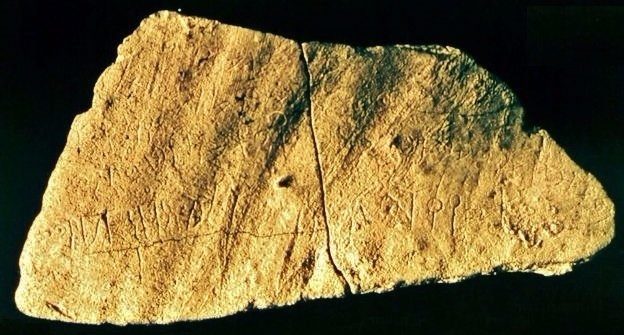 |
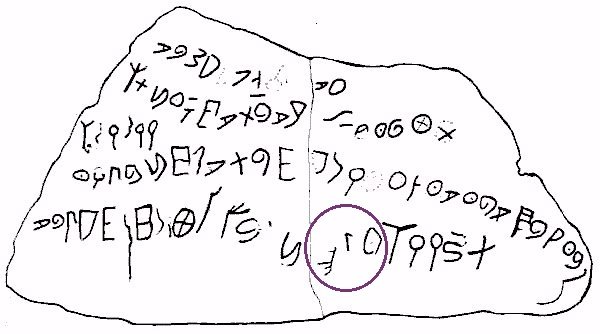 |
|
The Izbet Sartah ostracon. The bottom line is an abecedarie written from left to right. The samech, pe, and ayin are circled.
|
|
Kuntillet ‘Ajrud – During excavations in 1975-76 at Kuntillet ‘Ajrud, a site in the northeast Sinai, a jar fragment was discovered that included three Hebrew abecedaries in which the pe precedes the ayin.[17] The site dates to approximately 800 B.C.E., and although it is far south, Ze’ev Meshel, the archaeologist who led the excavations, believes it is an Israelite (not Judahite) site based in part on the strong northern influence found there.[18]
Tel Zayit – In 2005, a Hebrew abecedary inscribed on a stone was discovered at Tel Zayit, a site north of Lachish. The stone had been used in the construction of a wall belonging to a 10thcentury B.C.E. structure. This abecedary seems to follow the order of pe preceding ayin, though due to poor preservation this is not entirely certain.[19] Tel Zayit was part of Judah in the 10th century B.C.E.[20]
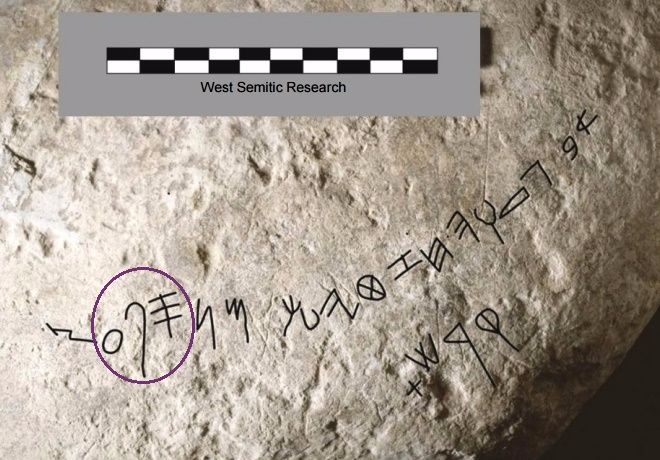
Ostracon of Unknown Provenance – In recent years, another ostracon with three Hebrew abecedaries has come to light, all three with pe preceding ayin.[21] The provenance of the ostracon is unknown, but the writing can be dated paleographically to the late seventh or early 6th century B.C.E.
Always Pe-Ayin
These abecedaries are the only aleph-bet abecedaries spanning the letters ayin and pe[22] dating to the pre-exilic period that have been discovered in ancient Israel. They come from different regions in ancient Israel, and pe precedes ayin in every one.[23] This suggests that the pe-ayin order was the only order in use in Israel in these early periods.[24]
Evidence from Epigraphy
One final piece of evidence for the pe-ayin order comes from epigraphy. The eminent epigrapher (scholar of inscriptions), Christopher Rollston, has shown that in Hebrew inscriptions from the eighth through sixth centuries B.C.E., when samekh is immediately followed by pe, the two letters are consistently written the same way in relation to one another:
The samek always ascends to a height above the register’s ceiling line, while the pe nestles snuggly below the left edge of the samek’s lowest crossbar.[25]
One illustrative example of this, is the word kesef (כ.ס.פ, “silver”) in the Shebna Inscription (“Royal Steward Inscription”) from 8th century Judah (the word is circled):
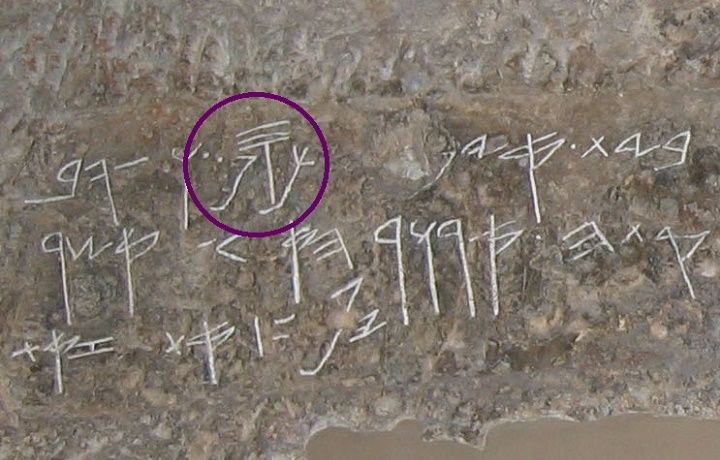
Such consistency in writing two adjacent letters is otherwise atypical but it is such a standard feature of ancient Hebrew inscriptions that Rollston has even used the lack of this feature as a supporting argument against forgeries![26] Ryan Byrne explains this pattern by suggesting that the Israelite scribes of this period may have been trained in an order in which samekhwas followed by pe, in other words, where ayin followed pe.[27]
Ancient Abecedaries from Outside Israel and Judah
In contrast to the Israelite and Judahite abecedaries surveyed above, the ancient abecedaries in Western Semitic[28]languages from this same period from regions outside Israel reflect the ayin-pe order:
Ugaritic Abecedaries – Ancient Ugarit, discovered in 1929, is the modern site of Ras Shamra, on the Mediterranean coast of North Syria. The language spoken there, Ugaritic, is a Semitic language and was written in alphabetic cuneiform. (In other words, they used an alphabet, but the letters look entirely different than the Hebrew alphabet, and the writing was on tablets or stone, in the cuneiform style, instead of on parchment or papyrus.) Among the texts discovered in Ugarit include abecedaries that date from the 13th century B.C.E. In the several abecedaries in the aleph-bet scheme long enough to span ayin and pe, the cuneiform sign for the ayin precedes the cuneiform sign for the pe.[29]
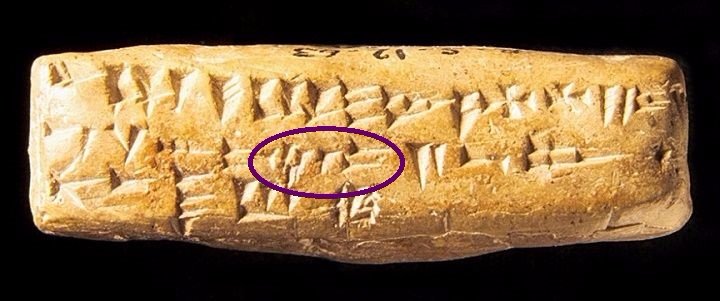
 , and pe
, and pe  (left to right) are circled. Credit: Unesco.org
(left to right) are circled. Credit: Unesco.orgAn Aramaic Abecedary – Among the other Western Semitic languages, i.e., Aramaic, Ammonite, Moabite, and Phoenician, only one abecedary has been discovered from this period that is long enough to span ayin and pe. It is an 8th century Aramaic inscription from Tell Halaf in northeastern Syria, and here too,ayin precedes pe.[30]
Israelite vs. Non-Israelite Order
This evidence, though sparse, suggests that two separate orders existed for the aleph bet in the ancient period. One used by the Israelites and Judahites, had pe before ayin. The other, used outside the area of Israel and Judah, had ayin before pe.
Reordering the Alphabet in Post-Exilic Times
At some point in the exilic or post-exilic period, the ayin beforepe order was likely adopted by the Judeans. Given that they largely abandoned the Hebrew script for the Aramaic script, it is not surprising that they also adopted the Aramaic letter order.
From then on, the ayin-pe order became standard in Hebrew as it is in Aramaic, Greek, and Latin alphabets (o comes before p, of course) and acrostics written in the post-exilic period follow the ayin-pe order (as they do in many texts from Psalms). This also explains what happened in texts such as the Woman of Valor (Prov 31) and Lamentations 1: they were “corrected” by later scribes, although why these were corrected and not Lam. 2-4 is unknown.
Ancient Pe-Ayin Acrostics in Psalms
Since we have seen that later scribes corrected earlier texts to fit with the ayin-pe order of the post-exilic alphabet, it seems possible that this may have happened to other pre-exilic texts, even when we lack textual witness. I believe this is what happened to the remaining three acrostics in the first book of Psalms (25, 34, 37), which is the earliest section of the book and which many scholars date to the pre-exilic period.[31] This is in contrast to the acrostics in the fifth book of psalms, 111, 112, 119, 145, which are all post-exilic and all naturally follow the ayin-peh order.
If the acrostics in the first book of Psalms are pre-exilic, then psalms 25, 34, and 37 should follow the pe-ayin order as 9-10 does. In fact, despite no textual witnesses to this effect, I believe it is possible to demonstrate the superiority of the pe-ayin order in at least one of these psalms.
Psalm 34
The flow of the ayin-pe verses in Psalm 34 has troubled Biblical commentators throughout the ages:
תהלים לד:טז עֵינֵי יְ-הוָה אֶל צַדִּיקִים
וְאָזְנָיו אֶל שַׁוְעָתָם.
Ps 34:16 The eyes of YHWH are on the righteous,
His ears attentive to their cry.
לד:יז פְּנֵי יְ-הוָה בְּעֹשֵׂי רָע
לְהַכְרִית מֵאֶרֶץ זִכְרָם.
34:17 The face of YHWH is set against evildoers,
To erase their remembrance from the earth.
לד:יח צָעֲקוּ וַי-הוָה שָׁמֵעַ
וּמִכָּל צָרוֹתָם הִצִּילָם.
34:18 They cry out, and YHWH hears,
And saves them from all their troubles.
Note the difficult transition between verse 17 and 18: Why should God listen to and save the evildoers, when we have just been told that He wants to cut off the remembrance of them from the earth? Bothered by this problem, ibn Ezra suggests that the evildoers were depressed by their actions and changed their ways.[32] He defends this reading by pointing to the next verse, with its description of God as close to the “broken-hearted”:
תהלים לד:יט קָרוֹב יְ-הוָה לְנִשְׁבְּרֵי לֵב
וְאֶת דַּכְּאֵי רוּחַ יוֹשִׁיעַ.
Ps 34:19 YHWH is close to the brokenhearted;
Those crushed in spirit He delivers.
Nevertheless, ibn Ezra’s reading here seems overly subtle. Moreover, v. 17 says that the evildoers will be wiped from the earth, not that they will be crushed by remorse and repent.[33]
A more persuasive solution, suggested by a number of scholars, including the German Bible scholar, Hermann Gunkel (1862-1932),[34] is to assume that pe preceded ayin here, and that the ones whom God listens to and saves are not the evildoers, but the righteous:
תהלים לד:טו סוּר מֵרָע וַעֲשֵׂה טוֹב
בַּקֵּשׁ שָׁלוֹם וְרָדְפֵהוּ.
Ps 34:15 Shun evil and do good,
Seek amity and pursue it.
לד:יז פְּנֵי יְ-הוָה בְּעֹשֵׂי רָע
לְהַכְרִית מֵאֶרֶץ זִכְרָם.
34:17 The face of YHWH is set against evildoers,
To erase their names from the earth.
לד:טז עֵינֵי יְ-הוָה אֶל צַדִּיקִים
וְאָזְנָיו אֶל שַׁוְעָתָם.
34:16 The eyes of YHWH are on the righteous,
His ears attentive to their cry.
לד:יח צָעֲקוּ וַי-הוָה שָׁמֵעַ
וּמִכָּל צָרוֹתָם הִצִּילָם.
34:18 They cry out, and YHWH hears,
And saves them from all their troubles.
The theological problem disappears and the sequence of verses makes perfect sense! I believe that a similar process occurred with Psalms 25 and 37 (see appendix.)
The Pre-Exilic and Early Exilic Pe-Ayin Alphabet
In short, it seems likely that all the acrostics of the first book of Psalms, which were likely composed in the pre-exilic period, were written with the pe-ayin order. This same pe-ayin order was used for all four acrostics in the early exilic (pre-Persian Period) book of Lamentations and in the paean to the “woman of valor” in Proverbs 31.[35] Only with the change in alphabet, after the Judahites’ long exposure to Aramaic writing, did the order change. Later scribes adjusted some of these (Lam 1, Prov 31, Ps 25, 34, 37) but not others (Lam 2-4, Ps 9-10), leaving the latter as evidence for the original ordering of these letters in the pre-exilic period.
This biblical evidence, however, was not really understood until the discovery of the abecedaries. The anomalous acrostics in the Bible can finally be understood for what they are, reflections of the original Israelite and Judahite alphabet.
Appendix
Reconstructing a Pe-Ayin Order in Psalms 25 and 37
The argument that Psalms 25 and 37 also originally followed the pe-ayin order is less compelling, but still quite likely.[36] At the very least, nothing contextually suggests that their current order, rather than a pe-ayin order, is necessary.
Psalm 25
The ayin-pe verses in Psalm 25 present no difficulty.[37]Nevertheless, if we present the text in the pe-ayin order, we still have a coherent text, and even uncover a parallel between the second halves of the newly adjacent verses 15 and 17:
תהלים כה:טז פְּנֵה אֵלַי וְחָנֵּנִי
כִּי יָחִיד וְעָנִי אָנִי.
Ps 25:16 Turn to me, have mercy on me,
For I am alone and afflicted.
כה:טו עֵינַי תָּמִיד אֶל יְ-הוָה
כִּי הוּא יוֹצִיא מֵרֶשֶׁת רַגְלָי.
25:15 My eyes are ever toward YHWH,
For He will loose my feet from the net.
כה:יז צָרוֹת לְבָבִי הִרְחִיבוּ
מִמְּצוּקוֹתַי הוֹצִיאֵנִי.
25:17 My deep distress increases;
Deliver me from my straits.
The likelihood that chapter 25 was in this order is buttressed by the many parallels it shares with chapter 34:
- Both add an extra pe verse at their conclusion of the psalm.
- The added pe verse is from the same root (פדה) in both.
- Each letter of the alphabet is assigned only one verse.[38]
- Both lack a vav [39]
Psalm 37
In the MT,[40] Psalm 37 is missing an ayin section. Its samekh section (vv. 27-28), however, is unusually long and syntactically difficult exactly at the point where we would have expected an ayin verse to begin in an ayin-pe acrostic (v. 28b).[41]
The word that may have begun with ayin is likely preserved by the LXX.[42]
| Reconstructed Hebrew | LXX | English Translation |
|
עַוָּלִים נִשְׁמָדוּ[43]
|
ἄνομοι δὲ ἐκδιωχθήσονται | The lawless shall be banished, |
|
וְזֶרַע רְשָׁעִים נִכְרָת.
|
καὶ σπέρμα ἀσεβῶν ἐξολεθρευθήσεται[44] | And the children of the wicked will be cut off. |
As was true of Psalm 25, the ayin-pe order here (following the LXX) poses no difficulty, though neither would a pe-ayinorder. In favor of the possibility of an original pe-ayin order here, I can only note that it is telling that it is specifically the ayin text that was corrupted. I suggest that this is not a coincidence but may reflect an error made in the course of the re-ordering of the psalm from a pe-ayin acrostic into an ayin-pe acrostic.[45]
TheTorah.com is a 501(c)(3) nonprofit organization.
We rely on the support of readers like you. Please support us.
Published
July 28, 2017
|
Last Updated
October 21, 2025
Previous in the Series
Next in the Series
Before you continue...
Thank you to all our readers who offered their year-end support.
Please help TheTorah.com get off to a strong start in 2025.
Footnotes

Mitchell First is an attorney, with an M.A. in Jewish History from the Bernard Revel Graduate School. He is the author of Roots and Rituals: Insights into Hebrew, Holidays, and History, as well as Esther Unmasked: Solving Eleven Mysteries of the Jewish Holidays and Liturgy and Jewish History in Conflict: A Study of the Major Discrepancy Between Rabbinic and Conventional Chronology, and Links to Our Legacy: Insights into Hebrew, History, and Liturgy, and Words for the Wise: Sixty-Two Insights on Hebrew, Holidays, History and Liturgy. His website is www.rootsandrituals.org.
Essays on Related Topics:









